The rocky hills and sagebrush-covered flats at the base of the Sierra Nevada Mountains extending east to Lone Pine, California, and beyond have a lengthy and illustrious movie history. For decades, the distinctive contours and colors of this rocky landscape backed by Mount Whitney and other majestic snow covered peaks have provided a spectacular setting for countless tales of Hollywood’s Old West, as well as such exotic locations as India, China, and Afghanistan, and occasionally even other planets.
Lone Pine is situated in the  Owens Valley directly on U.S. Highway 395 just 16 miles south of Independence and approximately 200 miles north of Los Angeles. The Owens Valley is known to have been prehistorically inhabited by the Paiute people who established routes extending to the Pacific Central Coast to enable trade with tribes such as the Chumash. The picturesque Alabama Hills lying to the west of Lone Pine on the eastern slope of the Sierra Nevada Mountains were so-named in 1862 to commemorate the victories of the Confederate ship CSS Alabama.
Owens Valley directly on U.S. Highway 395 just 16 miles south of Independence and approximately 200 miles north of Los Angeles. The Owens Valley is known to have been prehistorically inhabited by the Paiute people who established routes extending to the Pacific Central Coast to enable trade with tribes such as the Chumash. The picturesque Alabama Hills lying to the west of Lone Pine on the eastern slope of the Sierra Nevada Mountains were so-named in 1862 to commemorate the victories of the Confederate ship CSS Alabama.
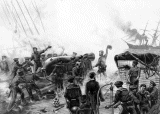 When news of the warship's exploits reached Southern sympathizers who were prospecting for California gold, these prospectors named many mining claims after the ship, until eventually the entire range became known as the Alabama Hills. Then, when the Alabama was sunk off the coast of Normandy by USS Kearsarge in 1864, prospectors sympathetic to the North named a mining district, a mountain pass, a mountain peak, and a town after the Kearsarge.
When news of the warship's exploits reached Southern sympathizers who were prospecting for California gold, these prospectors named many mining claims after the ship, until eventually the entire range became known as the Alabama Hills. Then, when the Alabama was sunk off the coast of Normandy by USS Kearsarge in 1864, prospectors sympathetic to the North named a mining district, a mountain pass, a mountain peak, and a town after the Kearsarge.
On March 26, 1872, one of the largest earthquakes in recorded history hit California with its epicenter near Lone Pine. The true size of this earthquake is not known, but historical evidence detailing the damage it caused in settlements and landforms near the epicenter, and the geographic extent to which noticeable movement was felt, leads researchers to
estimate a Richter magnitude of 7.6 to 8 or greater — similar in size to the 1906 San Francisco earthquake. The quake hit at 2:35 on a Tuesday morning and leveled almost all the buildings in Lone Pine and nearby settlements.
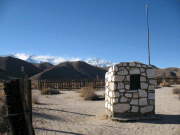 Of the estimated 250-300 inhabitants of Lone Pine, 27 are known to have perished and 52 of the 59 houses were destroyed. One report stated that the main buildings were thrown down in almost every town in Inyo County. The quake was felt strongly as far north as Sacramento, where citizens were startled out of bed and into the streets, and as far south as San Diego stopping clocks and awakening people. The shock was felt over most of California and much of Nevada. Thousands of aftershocks occurred, some severe. Just north of town, a monument and mass grave of the earthquake victims is located near one fault line. The hastily contrived and dug cemetery contains the remains of at least 16 people who perished in the earthquake.
Of the estimated 250-300 inhabitants of Lone Pine, 27 are known to have perished and 52 of the 59 houses were destroyed. One report stated that the main buildings were thrown down in almost every town in Inyo County. The quake was felt strongly as far north as Sacramento, where citizens were startled out of bed and into the streets, and as far south as San Diego stopping clocks and awakening people. The shock was felt over most of California and much of Nevada. Thousands of aftershocks occurred, some severe. Just north of town, a monument and mass grave of the earthquake victims is located near one fault line. The hastily contrived and dug cemetery contains the remains of at least 16 people who perished in the earthquake.
Geographically, the Alabama Hills are considered a range of hills, but geologically they are part of the Sierra Nevada Mountains. The Alabama Hills are a protected habitat
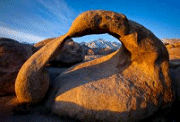 and managed by the U.S. Bureau of Land Management (BLM). Mt. Whitney, the tallest mountain in the contiguous United States, towers several thousand feet above the low range, which itself is 1,500 feet above the Owens Valley floor. Dozens of natural arches are among the main attractions at the Alabama Hills. They can be accessed by short hikes from the Whitney Portal Road, the Movie Flat Road and the Horseshoe Meadows Road. Among the notable features of the area are Mobius Arch, Lathe Arch, the Eye of Alabama and Whitney Portal Arch.
and managed by the U.S. Bureau of Land Management (BLM). Mt. Whitney, the tallest mountain in the contiguous United States, towers several thousand feet above the low range, which itself is 1,500 feet above the Owens Valley floor. Dozens of natural arches are among the main attractions at the Alabama Hills. They can be accessed by short hikes from the Whitney Portal Road, the Movie Flat Road and the Horseshoe Meadows Road. Among the notable features of the area are Mobius Arch, Lathe Arch, the Eye of Alabama and Whitney Portal Arch.
This sleepy community in California’s high desert country lured movie companies because it offered a rugged romantic mountain setting within a reasonable driving distance of Hollywood. Directors and cinematographers loved filming in the Alabama
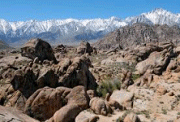 Hills just west of town where the distinctive rocks extended far into the distance and offered a perfect way to display motion and expanse. The snow-covered white granite Sierra Nevada in the background filled the frame and contrasted perfectly with the darker Alabama Hills.
Hills just west of town where the distinctive rocks extended far into the distance and offered a perfect way to display motion and expanse. The snow-covered white granite Sierra Nevada in the background filled the frame and contrasted perfectly with the darker Alabama Hills.
From the beginning, many Lone Pine residents worked for the movie companies and support industries, some of them as stuntmen and extras. Al Gallagher was the first rancher to provide the horses and cattle that filmmakers needed; but it was Russell Spainhower, another local rancher, who built a business around supplying the movie people with whatever they needed for filming. In addition to supplying horses and cattle, Spainhower provided wagons, stagecoaches and other Western props. He also signed up local residents and cowboys to work on and in the pictures. Eventually, Spainhower built a Spanish mission set and later added a Western town and street set on his Anchor Ranch, a sprawling spread just south of town along Highway 395. The Anchor Ranch can be seen in many of the Hopalong Cassidy and post-war Tim Holt movies. In addition to the Anchor Ranch, other local area ranches were also used as film locations, including the Lubkin Ranch (south of town) and the Mather Ranch (west of town).
By most accounts, the first movie filmed in the Lone Pine area was Paramount’s The Roundup, which began filming in early September 1919 and starred silent
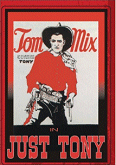 screen comedian Roscoe ‘Fatty’ Arbuckle. Then the Hollywood cowboys came and for nearly 40 years they continued to come, shooting dozens of sagebrush sagas. It was not unusual for more than one principal production unit to be working in the area at the same time. Among the first Western heroes to utilize Lone Pine locations were Fox’s Tom Mix in Just Tony (1922), and Buck Jones in Durand of the Bad Lands (1925). They were soon followed by Universal Pictures’ cowboy favorites Hoot Gibson, Ken Maynard, Fred Gilman, Fred Humes and Jack Hoxie, who worked in Lone Pine more than any other silent movie cowboy and starred in more than a dozen films during the 1920s.
screen comedian Roscoe ‘Fatty’ Arbuckle. Then the Hollywood cowboys came and for nearly 40 years they continued to come, shooting dozens of sagebrush sagas. It was not unusual for more than one principal production unit to be working in the area at the same time. Among the first Western heroes to utilize Lone Pine locations were Fox’s Tom Mix in Just Tony (1922), and Buck Jones in Durand of the Bad Lands (1925). They were soon followed by Universal Pictures’ cowboy favorites Hoot Gibson, Ken Maynard, Fred Gilman, Fred Humes and Jack Hoxie, who worked in Lone Pine more than any other silent movie cowboy and starred in more than a dozen films during the 1920s.
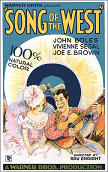 The maze of roads winding through the Alabama Hills was originally carved so the movie companies could get their equipment to the various location sites. The first sound film shot at Lone Pine was Universal Pictures’ The Wagon Master (1929). This Ken Maynard production coincidentally was the first sound B-Western to feature a singing cowboy. For Song of the West (1930), a 2-strip Technicolor musical Western starring John Boles and Joe E. Brown, Warner Brothers built the first complete town set in the large flat area just north of Movie Road in the S curve along Whitney Portal Road. The area has been called Red Dog after the town ever since.
The maze of roads winding through the Alabama Hills was originally carved so the movie companies could get their equipment to the various location sites. The first sound film shot at Lone Pine was Universal Pictures’ The Wagon Master (1929). This Ken Maynard production coincidentally was the first sound B-Western to feature a singing cowboy. For Song of the West (1930), a 2-strip Technicolor musical Western starring John Boles and Joe E. Brown, Warner Brothers built the first complete town set in the large flat area just north of Movie Road in the S curve along Whitney Portal Road. The area has been called Red Dog after the town ever since.
After the first talkies were made in Lone Pine in 1929 and 1930, the area’s movie business really began to expand, led by Maynard, Gibson and Mix who had been working there for years.
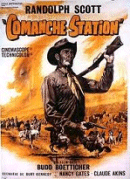 A new group of cowboy stars, studios, and independent production units large and small alike began taking advantage of the spectacular scenery. The newcomers included RKO Pictures’ Tom Keene and John Wayne, making films initially for First National Warner Brothers and later for Republic Pictures. George O’Brien and Randolph Scott, representing Fox and Paramount respectively, carried on Lone Pine’s connection with movies adapted from novels by bestselling Western author Zane Grey. Scott’s first trip to the area to star in Paramount Pictures’ The Thundering Herd (1932) began a nearly 30-year relationship with Lone Pine that did not end until his announced retirement upon finishing Comanche Station there in 1960. During the Depression years, independent companies featuring such stars as Bob Steel, Tom Tyler and Johnny Mack Brown, shot movies in the hills and in the town itself. These films became part of the seemingly endless stream of B-Westerns that filled the thousands of theaters showing Saturday matinees to young thrill-hungry audiences.
A new group of cowboy stars, studios, and independent production units large and small alike began taking advantage of the spectacular scenery. The newcomers included RKO Pictures’ Tom Keene and John Wayne, making films initially for First National Warner Brothers and later for Republic Pictures. George O’Brien and Randolph Scott, representing Fox and Paramount respectively, carried on Lone Pine’s connection with movies adapted from novels by bestselling Western author Zane Grey. Scott’s first trip to the area to star in Paramount Pictures’ The Thundering Herd (1932) began a nearly 30-year relationship with Lone Pine that did not end until his announced retirement upon finishing Comanche Station there in 1960. During the Depression years, independent companies featuring such stars as Bob Steel, Tom Tyler and Johnny Mack Brown, shot movies in the hills and in the town itself. These films became part of the seemingly endless stream of B-Westerns that filled the thousands of theaters showing Saturday matinees to young thrill-hungry audiences.
The narrow passes and rugged rocks of the Alabama Hills
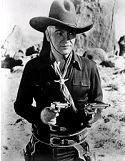 have provided the backdrops for hundreds of Westerns featuring cowboy stars both famous and obscure. Whether doing the chasing or being chased, the good guys in the white hats were a familiar sight in the Alabama Hills; but it is the good guy wearing a black hat who is most identified with the Lone Pine area - Hopalong Cassidy. For Hoppy, the area stood in for Texas or Old Mexico or Argentina or Wyoming where the fictional Bar 20 was located. William Boyd made 66 features starring as Hopalong Cassidy, and 30 of them were shot in or around Lone Pine.
have provided the backdrops for hundreds of Westerns featuring cowboy stars both famous and obscure. Whether doing the chasing or being chased, the good guys in the white hats were a familiar sight in the Alabama Hills; but it is the good guy wearing a black hat who is most identified with the Lone Pine area - Hopalong Cassidy. For Hoppy, the area stood in for Texas or Old Mexico or Argentina or Wyoming where the fictional Bar 20 was located. William Boyd made 66 features starring as Hopalong Cassidy, and 30 of them were shot in or around Lone Pine.
The other great character most closely identified with
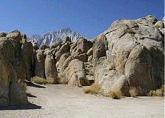 the area is the Lone Ranger. In 1938, Republic Pictures chose the Alabama Hills as the setting for its screen adaptation of the adventures of the 1930s radio hero, filming what many consider the best movie serial ever made. Eighty years later, the location for the key scene in the rocks where the troop of Texas rangers was ambushed leaving only one survivor is still referred to as “Lone Ranger Ambush Canyon.”
the area is the Lone Ranger. In 1938, Republic Pictures chose the Alabama Hills as the setting for its screen adaptation of the adventures of the 1930s radio hero, filming what many consider the best movie serial ever made. Eighty years later, the location for the key scene in the rocks where the troop of Texas rangers was ambushed leaving only one survivor is still referred to as “Lone Ranger Ambush Canyon.”
Beginning in the mid-1930s, the voices of the popular Singing Cowboys Gene Autry and Roy Rogers often echoed in the canyons of the Alabama Hills while their production units filmed. Even Tex Ritter made the trip up Highway 395 for a couple of his Monogram musical oaters. Westerns were not the only movies to be filmed in Lone Pine by the Hollywood production companies. When film crews returned to Hollywood and talked about the spectacularly rugged scenery, it was not long before studio location managers realized that the Sierras could double as other mountain ranges in a variety of film genres.
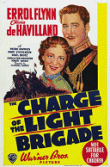 In the 1930s, actors, stuntmen and extras garbed themselves as British soldiers protecting the empire and roamed the Alabama Hills in Paramount Pictures’ The Lives of a Bengal Lancer (1935) starring Gary Cooper, Warner Brothers’ The Charge of the Light Brigade (1936) starring Errol Flynn, and Republic Pictures’ Storm Over Bengal (1938) starring Patric Knowles. By far, the biggest and most important production ever made in the area was the 1939 epic Gunga Din, starring Cary Grant and Douglas Fairbanks, Jr.
In the 1930s, actors, stuntmen and extras garbed themselves as British soldiers protecting the empire and roamed the Alabama Hills in Paramount Pictures’ The Lives of a Bengal Lancer (1935) starring Gary Cooper, Warner Brothers’ The Charge of the Light Brigade (1936) starring Errol Flynn, and Republic Pictures’ Storm Over Bengal (1938) starring Patric Knowles. By far, the biggest and most important production ever made in the area was the 1939 epic Gunga Din, starring Cary Grant and Douglas Fairbanks, Jr.
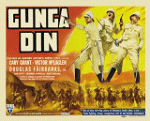 Filmed almost entirely in the Alabama Hills, Gunga Din utilized massive, expensive sets built by RKO which included an elaborate temple, an entire Hindu town, and a British Army post complete with a parade ground. For the 10 weeks of shooting, the studio built a huge tent city to house the film crew, technicians, and the 900+ extras needed throughout the production for the huge battle sequences.
Filmed almost entirely in the Alabama Hills, Gunga Din utilized massive, expensive sets built by RKO which included an elaborate temple, an entire Hindu town, and a British Army post complete with a parade ground. For the 10 weeks of shooting, the studio built a huge tent city to house the film crew, technicians, and the 900+ extras needed throughout the production for the huge battle sequences.
 In Lone Pine, the 1940s began with Tyrone Power in Brigham Young (1940) and Humphrey Bogart in High Sierra (1941) making the trek up from Hollywood; Harry Sherman producing Paramount’s last Zane Grey films; and Hopalong Cassidy chasing the bad guys through the hills. In 1940, another popular Western character, the Cisco Kid, also rode in the shadow of the Sierras. In addition to the Hoppy films, Harry Sherman’s production unit filmed a group of historical Westerns including a remake of The Roundup (1941), the first film shot in the area, starring Richard Dix and Preston Foster. During the war years, more than a film a month was shot in and around Lone Pine.
In Lone Pine, the 1940s began with Tyrone Power in Brigham Young (1940) and Humphrey Bogart in High Sierra (1941) making the trek up from Hollywood; Harry Sherman producing Paramount’s last Zane Grey films; and Hopalong Cassidy chasing the bad guys through the hills. In 1940, another popular Western character, the Cisco Kid, also rode in the shadow of the Sierras. In addition to the Hoppy films, Harry Sherman’s production unit filmed a group of historical Westerns including a remake of The Roundup (1941), the first film shot in the area, starring Richard Dix and Preston Foster. During the war years, more than a film a month was shot in and around Lone Pine.
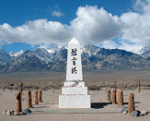 Approximately 10 miles north of Lone Pine and located at the foot of the Sierra Nevada Mountains is Manzanar, widely known as the site of one of ten camps where over 110,000 Japanese Americans were imprisoned during World War II. Manzanar, which in Spanish means ‘apple orchard’, has been identified by the U.S. National Park Service as the best-preserved of the former relocation camp sites and has been designated the Manzanar National Historic Site.
Approximately 10 miles north of Lone Pine and located at the foot of the Sierra Nevada Mountains is Manzanar, widely known as the site of one of ten camps where over 110,000 Japanese Americans were imprisoned during World War II. Manzanar, which in Spanish means ‘apple orchard’, has been identified by the U.S. National Park Service as the best-preserved of the former relocation camp sites and has been designated the Manzanar National Historic Site.
Long before the first prisoners arrived in March 1942, Manzanar was home to Native Americans, who mostly lived in villages near several creeks in the area. Ranchers and miners formally established the town of Manzanar in 1910, but abandoned the town by 1929 after the City of Los Angeles purchased the water rights to virtually the entire area. It is interesting to note that despite their differences, Manzanar’s inhabitants have shared a common thread of forced relocation
After the December 7, 1941, attack on Pearl Harbor, the United States government swiftly moved to begin solving the “Japanese Problem” on the West Coast. In the evening hours of that same day, the Federal Bureau of Investigation (FBI) arrested selected “enemy” aliens, including 2,192 who were of Japanese descent. The California government pressed the federal government to act, as many citizens were alarmed about potential activities by people of Japanese descent.
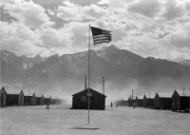 On February 19, 1942, President Franklin D. Roosevelt signed Executive Order 9066, which authorized the Secretary of War to designate military commanders to establish military areas and to exclude “any or all persons” from such areas. The order also authorized the construction of what would later be called “relocation centers” by the War Relocation Authority (WRA) to house those who were to be excluded. This order resulted in the forced relocation of over 120,000 Japanese Americans, two-thirds of whom were native-born American citizens. The rest had been prevented from becoming citizens by federal law. Over 110,000 were imprisoned in the ten concentration camps located far inland and away from the coast. Manzanar was the first of the ten concentration camps to be established. Initially a temporary “reception center”, it was known as the Owens Valley Reception Center from March 21 to May 31, 1942, and was operated by the US Army's Wartime Civilian Control Administration (WCCA).
On February 19, 1942, President Franklin D. Roosevelt signed Executive Order 9066, which authorized the Secretary of War to designate military commanders to establish military areas and to exclude “any or all persons” from such areas. The order also authorized the construction of what would later be called “relocation centers” by the War Relocation Authority (WRA) to house those who were to be excluded. This order resulted in the forced relocation of over 120,000 Japanese Americans, two-thirds of whom were native-born American citizens. The rest had been prevented from becoming citizens by federal law. Over 110,000 were imprisoned in the ten concentration camps located far inland and away from the coast. Manzanar was the first of the ten concentration camps to be established. Initially a temporary “reception center”, it was known as the Owens Valley Reception Center from March 21 to May 31, 1942, and was operated by the US Army's Wartime Civilian Control Administration (WCCA).
The Owens Valley Reception Center was transferred to the WRA on June 1, 1942, and officially became the "Manzanar War Relocation Center". The first Japanese American prisoners to arrive at Manzanar were volunteers who helped build the camp. By mid–April up to 1,000 Japanese Americans were arriving daily, and by July the population of the camp neared 10,000. Over 90% of the prisoners were from the Los Angeles area, with the rest coming from Stockton, California, and Bainbridge Island, Washington. Many were farmers and fishermen. Manzanar held 10,046 prisoners at its peak, and a total of 11,070 people were imprisoned there.
Although the end of World War II marked the beginning of the end for B-Western production overall, Lone Pine was at its peak hosting B units. Tim Holt made the first of over 20 Westerns in his RKO series, Under the Tonto Rim (1947), using the hills and
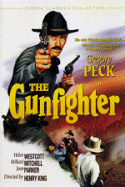 mountains of the area as backdrop. Gene Autry continued to be a regular and, of course, William Boyd still made the Alabama Hills and the Anchor Ranch home for the Hopalong Cassidy series. The last half of the decade, however, saw a gradual shift in Western production from the smaller B units to the larger studio A units which produced the more prestigious films that gradually replaced the Saturday matinee fare. John Wayne, by this time an international star, returned to Lone Pine to film Tycoon (1947) for RKO. Other major Westerns to be filmed in the Alabama Hills at the end of the decade included Yellow Sky (1948) with Anne Baxter and The Gunfighter (1950) with Helen Westcott, both starring Gregory Peck.
mountains of the area as backdrop. Gene Autry continued to be a regular and, of course, William Boyd still made the Alabama Hills and the Anchor Ranch home for the Hopalong Cassidy series. The last half of the decade, however, saw a gradual shift in Western production from the smaller B units to the larger studio A units which produced the more prestigious films that gradually replaced the Saturday matinee fare. John Wayne, by this time an international star, returned to Lone Pine to film Tycoon (1947) for RKO. Other major Westerns to be filmed in the Alabama Hills at the end of the decade included Yellow Sky (1948) with Anne Baxter and The Gunfighter (1950) with Helen Westcott, both starring Gregory Peck.
 By the early 1950s, the days of the “B” cowboys in Lone Pine were about gone. Tim Holt, Gene Autry and Hopalong Cassidy were supplanted by Randolph Scott and Audie Murphy as the stars who filmed most frequently in the area. Randolph Scott starred in The Nevadan (1950) with Dorothy Malone, The Stranger Wore a Gun (1953) with Claire Trevor, Seven Men from Now (1956) with Gail Russell, Tall T (1957) with Richard Boone, Ride Lonesome (1959) with Karen Steele,
By the early 1950s, the days of the “B” cowboys in Lone Pine were about gone. Tim Holt, Gene Autry and Hopalong Cassidy were supplanted by Randolph Scott and Audie Murphy as the stars who filmed most frequently in the area. Randolph Scott starred in The Nevadan (1950) with Dorothy Malone, The Stranger Wore a Gun (1953) with Claire Trevor, Seven Men from Now (1956) with Gail Russell, Tall T (1957) with Richard Boone, Ride Lonesome (1959) with Karen Steele,
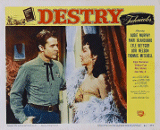 and finally Comanche Station (1960) with Nancy Gates. Audie Murphy starred in Ride Clear of Diablo (1954) with Susan Cabot, Destry (1954) with Mari Blanchard, Posse from Hell (1961) with John Saxon, and Showdown (1963) with Kathleen Crowley. Others who worked in Lone Pine more than once included Gary Cooper, Glenn Ford, Tyrone Power and Jack Palance. There were also other major leading female stars who filmed in Lone Pine, most notably Maureen O’Hara, Barbara Stanwyck, Susan Hayward and Virginia Mayo.
and finally Comanche Station (1960) with Nancy Gates. Audie Murphy starred in Ride Clear of Diablo (1954) with Susan Cabot, Destry (1954) with Mari Blanchard, Posse from Hell (1961) with John Saxon, and Showdown (1963) with Kathleen Crowley. Others who worked in Lone Pine more than once included Gary Cooper, Glenn Ford, Tyrone Power and Jack Palance. There were also other major leading female stars who filmed in Lone Pine, most notably Maureen O’Hara, Barbara Stanwyck, Susan Hayward and Virginia Mayo.
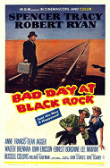 In 1955, MGM brought a cast and crew up for Bad Day at Black Rock, the most elaborate production in Lone Pine since Gunga Din in 1939. A complete town set was built to the northeast of town, so only a few key scenes were actually filmed in the Alabama Hills. This film, which starred Spencer Tracy, Robert Ryan, Anne Francis, Walter Brennan, Ernest Borgnine and Lee Marvin, remains one of the most important and best known of the Lone Pine films because of its wide exposure on television.
In 1955, MGM brought a cast and crew up for Bad Day at Black Rock, the most elaborate production in Lone Pine since Gunga Din in 1939. A complete town set was built to the northeast of town, so only a few key scenes were actually filmed in the Alabama Hills. This film, which starred Spencer Tracy, Robert Ryan, Anne Francis, Walter Brennan, Ernest Borgnine and Lee Marvin, remains one of the most important and best known of the Lone Pine films because of its wide exposure on television.
Television discovered the Alabama Hills in the early 1950s. The opening credits for The Lone Ranger, with the William Tell Overture blaring in the background, were filmed on Movie Road. Multiple episodes of Have Gun - Will Travel, Annie Oakley, Gunsmoke, Bonanza, Rawhide, and many other series were shot in the area. Even
The Twilight Zone made good use of the spectacular scenery offered in the hills. By 1960, with Western series proliferating on television, the market for big screen Westerns had dwindled significantly. Audie Murphy, the last great cowboy star, made his final Lone Pine film, Showdown (1963), early in the decade. Major sequences for MGM’s How the West Was Won (1962) were filmed in the Alabama Hills using Movie Road for a spectacular wagon train attack by Indians
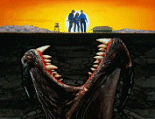 In the early 1970s Clint Eastwood used Lone Pine as the location for Joe Kid (1972), but by that time the Western was a dying genre. In recent years, Lone Pine has become a favorite location for producers of science fiction films, most notably Star Trek V: The Final Frontier (1989) and Tremors (1990). Although movie companies do not come to Lone Pine as often today, the rugged landscape can most recently be seen in the
In the early 1970s Clint Eastwood used Lone Pine as the location for Joe Kid (1972), but by that time the Western was a dying genre. In recent years, Lone Pine has become a favorite location for producers of science fiction films, most notably Star Trek V: The Final Frontier (1989) and Tremors (1990). Although movie companies do not come to Lone Pine as often today, the rugged landscape can most recently be seen in the
 opening sequence of Paramount Pictures’ Iron Man (2008) starring Robert Downey, Jr. and Jeff Bridges. In addition to the big screen, the Alabama Hills frequently appear as the backdrop for numerous television commercials and print ads. Nearly every make of American cars and many European models have been filmed on the back roads of the area. Commercials for motorcycles, banks, soft drinks and even candy have been produced in these hills. Yet despite the diversity of subjects filmed in the area, Lone Pine’s heritage will forever be defined by the indelible image of the American movie cowboy.
opening sequence of Paramount Pictures’ Iron Man (2008) starring Robert Downey, Jr. and Jeff Bridges. In addition to the big screen, the Alabama Hills frequently appear as the backdrop for numerous television commercials and print ads. Nearly every make of American cars and many European models have been filmed on the back roads of the area. Commercials for motorcycles, banks, soft drinks and even candy have been produced in these hills. Yet despite the diversity of subjects filmed in the area, Lone Pine’s heritage will forever be defined by the indelible image of the American movie cowboy.